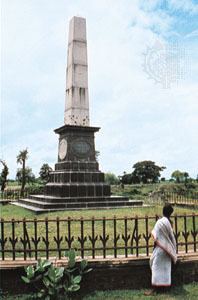PIN 741156 Elevation 17 m | Time zone IST (UTC+5:30) Telephone code 91 3474 Local time Tuesday 9:41 AM | |
 | ||
Weather 26°C, Wind S at 11 km/h, 61% Humidity | ||
Palashi (Bengali: পলাশী Pôlashi, pronounced [pəˈlaːsi]), also known as Plassey, is a village on the Bhagirathi river, located approximately 50 kilometres north of the city of Krishnanagar (কৃষ্ণনগর) in Kaliganj CD Block in the Nadia District of West Bengal, India. The nearest major town is Beldanga. It has its own two local gram panchayat.
Contents
Map of Palasi, West Bengal
It is particularly well known due to the Battle of Plassey fought there in 1757, between the private army of the British East India Company and the army of the king of Bengal Nawab Siraj Ud Daulah.
Etymology
The name Palashi is derived from the Bengali word for the red flower Pôlash (Bengali: পলাশ, English: Butea, Latin: Butea frondosa or Butea monosperma).
History
Palashi achieved historical significance when, on 23 June 1757, the Battle of Plassey was fought between the forces of Siraj Ud Daulah, the last Nawab of Bengal (and his French support troops) and the troops of the British East India Company, led by Robert Clive. This event, part of the Seven Years' War, ultimately led to the establishment of British rule in Bengal, and eventually, the whole Indian subcontinent. During British rule Plassey became part of Nadia District of Bengal.
Geography
Palashi is located in West Bengal,India at 23.80°N 88.25°E / 23.80; 88.25. It has an average elevation of 17 m (56 ft).
Culture and Memorials
There is a Monument established in memoirs of the battle. The Monument is protected and supervised by the Archaeological Survey of India. The grounds where the historic Battle of Plassey was fought is today marked with shrines, obelisks and memorials to the fallen generals and soldiers of Siraj Ud-Daulah. A set of three obelisks marks homage to the spot where Bakshi Mir Madan (the chief of the Nawab's artillery), Bahadur Ali Khan (Commander of Musketeers) and Nauwe Singh Hazari (the Captain of Artillery) were killed in the battle.
A plaque indicates that they fell here at 2 p.m on 23 June 1757 and were leaders of Nawab Siraj-Ud_Daula, at the head of the charge ordered by Mir Madan. Almost 5 km north from the Plassey battlefield, there is a Tomb of Farid Shah in Faridpur village, Dead body of Mir Madan was buried there.
A gold coloured statue of Siraj Ud Daula lies next to the Plassey Monument, in a clearing amidst mango orchards and fields. The tombs of Siraj Ud Daulah, Mir Jafar, their wives and a number of generals in Siraj's army lie close by around Murshidabad. Mausoleums built around the tombs of Siraj Ud-Daula, Azimunessa begum and other soldiers who fell in the war can be found close by at Khosh Bag and Jafarganj cemetery.
